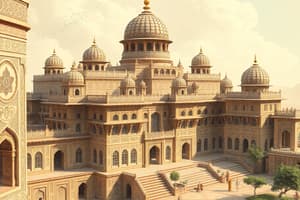Podcast
Questions and Answers
What is a distinctive feature of Harappan pottery?
What is a distinctive feature of Harappan pottery?
What were the Harappan seals primarily used for?
What were the Harappan seals primarily used for?
What remains a mystery despite efforts to decipher it in the Harappan Civilization?
What remains a mystery despite efforts to decipher it in the Harappan Civilization?
Which material was commonly used to make Harappan seals?
Which material was commonly used to make Harappan seals?
Signup and view all the answers
What architectural elements were prominent in Harappan cities?
What architectural elements were prominent in Harappan cities?
Signup and view all the answers
What type of items were traded by the Harappans in their extensive trade networks?
What type of items were traded by the Harappans in their extensive trade networks?
Signup and view all the answers
What was the role of priests in Harappan society?
What was the role of priests in Harappan society?
Signup and view all the answers
What evidence suggests the Harappans had a well-developed system of commerce?
What evidence suggests the Harappans had a well-developed system of commerce?
Signup and view all the answers
What characterized the standard of living for the elite class in the Harappan Civilization?
What characterized the standard of living for the elite class in the Harappan Civilization?
Signup and view all the answers
Which architectural feature in Mohenjo-Daro indicates advanced urban planning?
Which architectural feature in Mohenjo-Daro indicates advanced urban planning?
Signup and view all the answers
Study Notes
The Harappan Civilization: A Comprehensive Study
Nestled amidst the lush lands of the Indus Valley, the Harappan Civilization flourished as one of the world's first urban societies. This ancient empire left an indelible mark on history, leaving behind grand cities, impressive art, and a unique script that remains a mystery to this day. Let's delve into this fascinating society, exploring its artistic, literary, urban, and economic achievements.
Art and Pottery
Harappan culture is renowned for its exquisite pottery, with a wide range of forms and designs that show advanced skills in craftsmanship. Painted pottery, particularly red-on-buff and black-on-red styles, is a hallmark of this civilization. Pottery was not only functional but also ornate and decorative, often featuring animal figures, geometric patterns, and abstract designs.
Harappan art extended beyond pottery to include other materials like seals, small figurines, and beads. Seals, typically made from steatite stone, depict a variety of motifs including animals, plants, and geometric patterns. They were used for administrative purposes, likely to signify ownership and exchange.
Writing System
One of the Harappan Civilization's greatest enigmas is its script, discovered in the 1920s at the site of Harappa in Pakistan. The script has been found on seals, pottery, and other objects. Despite ongoing efforts to decipher the script, its meaning remains elusive. Numerous theories exist, but the language it represents and its purpose have yet to be proven definitively.
Urban Planning
Harappan cities were the largest of their time, with well-planned layouts often featuring a citadel, a lower town, and a grid of intersecting streets. The citadel, typically located on high ground, was the seat of political power and a religious center. In the lower town, houses, workshops, and other buildings were organized in a systematic layout. Exemplifying this urban planning is Mohenjo-Daro, India's oldest city, with its impressive drainage system and advanced sanitation features like covered wells and public baths.
Trade Networks
Harappan traders established extensive trade networks, linking the Indus Valley with Central Asia, Mesopotamia, and the Persian Gulf. They traded a wide variety of goods, including textiles, metals, and semiprecious stones. The Harappans' proficiency in trading can be inferred from the presence of standardized weights and measures, suggesting they had a well-developed system of commerce.
Social Structure
The Harappan Civilization had a stratified social structure, with evidence of elites, priests, craftspeople, and laborers. The elite class enjoyed a higher standard of living, as evidenced by their larger homes, imported goods, and access to other luxury items. Priests played a significant role in Harappan society, overseeing religious and civic life. The lower classes provided services and produced goods to support the elite's lifestyle.
The Harappan Civilization left a lasting impression on the world, and its achievements continue to inspire researchers and scholars alike. While much remains unknown about this ancient society, the clues it leaves behind speak of a civilization that was advanced, multifaceted, and one that still captivates the imagination.
Studying That Suits You
Use AI to generate personalized quizzes and flashcards to suit your learning preferences.
Description
Explore the artistry, mysterious script, urban structures, and trade networks of the ancient Harappan Civilization. Delve into their exquisite pottery, enigmatic writing system, well-planned cities, and extensive trade connections with neighboring regions.




